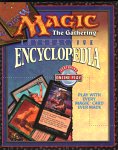|
|
 |


Get the MTG
Interactive Encyclopedia
from Amazon.com
|
 |
 |
The Beginning of
the 7th Era
Well, tommorow will be the first
day that the new base set, Seventh
Edition, will be legal for Standard play. It's
been two years since the last
time a new base set was introduced, and it brought
changes like no Ball
Lightning, Stasis, Nevinyrral's Disk, and Fallen Empires
storage
lands......er, wait, forget that last one. Sixth
Edition removed many
staples from the standard environment, without bringing
many amazing cards
into it, bringing Hammer of Bogardan and the Mirage
tutors as some of the
only format changing cards. Seventh Edition,
however, isn't removing many
staple cards from the enviornment, Armageddon and
Vampiric Tutor being the
only ones that I can think of offhand, but it does bring
many different cards
from Tempest and Saga block that have some interesting
possibilities.
Back in the days of Tempest and Saga
block type 2, a deck type that never
really became dominant, yet still showed up, was Burning
Bridge. It used the
combination of Ensnaring Bridge and Grafted Skullcap to
give you an
additional card during your draw step, and also prevent
any creatures with
power greater than 0 from attacking. It also used
Null Brooch, allowing you
to counter any non-creature spell with virtually no
drawback, considering
your hand would be empty anyway. For the kill, it
used Cursed Scroll, plus
old fashioned burn, drawing 2 cards a turn from the
Skullcap, then throwing
the burn at your opponent's head. Seventh Edition
has brought back the two
key components of the deck, Ensnaring Bridge and Grafted
Skullcap, allowing
the deck to function essentially the same. Two
reasons that this archetype
may gain more popularity than it had during it's
original play are that one,
the burn in the environment includes strong cards like
Urza's Rage and 4 more
Shocks, in the form of Seal of Fire, and the other
reason being the dominant
decks in the environment are very good matchups for the
deck, one example
being Fires, which completely buckles to an Ensnaring
Bridge.
Some old favorites made a comeback,
bringing back memories from nostalgic
players everywhere. The one that seems to have not been
improved on by the
sets that followed it is Mahumoti Djinn. In the
Sixth Edition type 2,
post-Invasion, the blue fatty of choice for many control
decks was Air
Elemental, an effecient 4/4 Flying for 5 mana, but with
Seventh Edition,
Mahumoti Djinn gets +1/+2 for only one more mana.
With alternate casting
cost countermagic like Thwart and Foil, a 'Moti can be
cast on turn 6 to hold
off assaults by Blastoderms and such, and still be
protected by one, and
maybe even two counterspells. This brings me to
another point, 'Moti can
block bigger creatures, such as Blastoderm and
Flametongue Kavu, without
dying, where as an Air Elemental would have to hold
back, or just trade with
a 4/4. I definitely think that 'Moti will see a
lot of play in type 2.
A card that I had completely
over-looked when I was going over the 7th
card list was Sleight of Hand. One day at the
local card shop, we had
decided to draft 7th, and that was the first time I had
seen it. There are
different arguments as to whether it or Opt is better,
and I am still unsure
of which is better. The only advantage that Opt
has over Sleight of Hand is
that it's an Instant as opposed to a Sorcery, allowing
you to hold back mana
on your opponent's turn. One deck that this
probably won't matter in is Blue
Skies, in which Sleight of Hand will replace Opt almost
for sure, but in
decks like mono blue control ("Chevy Blue") or
anything else with
countermagic, it is very debatable. Sleight of
Hand is a Sorcery, but it
basically takes the guessing out of an Opt, allowing you
to look at the top 2
cards of your library and choose one, instead of looking
at the top card, and
deciding whether you want to take the next card, or take
that one. A
situation where this would be better are if you're mana
light in the early
game, and you cast an Opt, finding a spell that costs 1
more mana than the
mana you have availible both in play and in hand.
You might be inclined to
take that spell, and hope to draw into a land in the
next one to two draw
steps, but with Sleight of Hand you can see the next
card, and if it's a
land, take it, and if it's not, then you've gone through
one more card in
your library, which is one more card closer to the next
land that you'll draw.
With US Nationals coming up in early
June, many people will be scouring
to find the best deck with seventh edition, either
adding new additions to
existing archetypes, or creating new ones altogether.
Either way, I will be
looking forward to seeing what proves popular, and what
ideas need to be
thrown away. Happy testing!
|
 |
|









